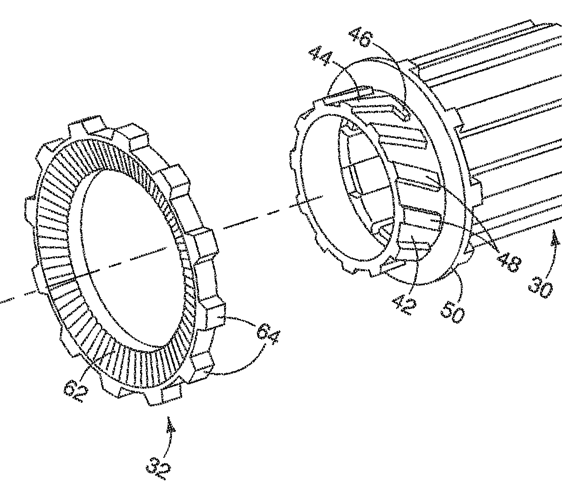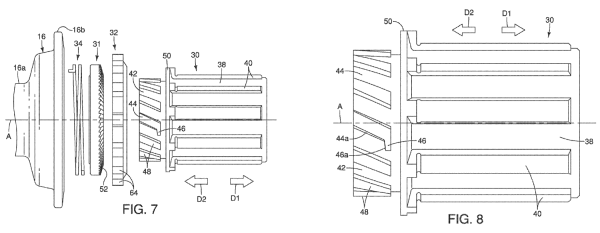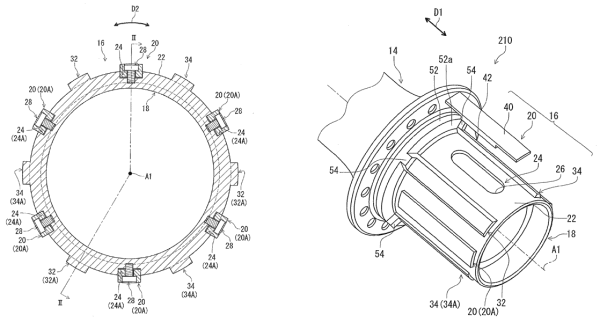Thanks to rumor and hearsay from a Bikerumor fan and our own digging, we hear Shimano’s working on all-new hub designs. one that could offer quick engagement, more durable freehub bodies and nearly silent, drag-free coasting. And we found a few patents to back it all up.
The biggest update to their current designs is the switch to a ring drive ratchet system. DT Swiss has proven it with their Star Ratchet, but Shimano’s filing actually references Chris King’s RingDrive patent, but there’s a major difference in the way Shimano’s design moves the ratchet rings. And that difference is what eliminates the buzzing bee sound during coasting, creating quiet, fast hub that might just be the heart of XTR and Dura-Ace’s next generation hubs…
Shimano’s current hubs use a standard ratchet and pawl system, clicking small, spring-loaded teeth on the freehub body into a ratchet ring mounted on the hub shell. That’s an improvement from earlier designs used on lower- and mid-level hubs like STX in the 90’s, where the ratchets and pawls were all contained in a replaceable freehub body. Those were prone to contamination but not rebuildable, and with the smaller overall diameter required to fit it all inside the FH body, things just weren’t as good.
This new design, which we hear is called Scylence, replaces pawls with two ratcheted rings and a conically slotted section on the freehub body. Before we dive into how it works, it’s worth seeing how similar systems like DT and Chris King work:
DT’s Star Ratchet uses two toothed rings, one inside the hubshell and one inside the FH body. Each is spring loaded to push against each other, and the teeth are angled such that when you pedal, they mesh together and turn the wheel. When coasting, the teeth’s angles are like ramps and the teeth simply bounce over each as the springs jiggle in micro compressions behind them. Because the teeth are always touching, you get the clicking noise. And because there are so many teeth, particularly on Chris King’s hubs, that noise can be high pitched and high volume. DT offers three different tooth counts on their rings, which make more or less noise depending. Higher tooth counts mean quicker engagement, but also (generally) more noise and more potential drag.
Shimano’s patent flips the script, slightly. And it’s brilliant. Only one of the ratchet rings (31) is spring loaded, but the spring (34) is pulling it away from the second ratchet ring (32), back towards the hub shell (16).
Inside the sprung ratchet ring (31) are slanted grooves (54/58) that catch the grooves (42/44) on the FH body (30). When you pedal, the FH body (30) spins and those grooves pull the sprung ratchet ring (31) into the floating ratchet ring (32) and the teeth connect and drive the hub shell, thus rotating the wheel and propelling you forward.
When not pedaling, those same grooves push the sprung ratchet ring (31) away from the floating ratchet ring (32), and the spring (34) assists in retracting and holding it, keeping the teeth from making any contact. That eliminates drag…and noise.
The floating ratchet ring (32) glides freely over the angled grooves on the FH body, but has splines (64) that fit into slots (18d). When it’s driven by the sprung ratchet ring, the wheel is turned.
So, rather than push two toothed rings together, Shimano’s found a way of pulling one set of teeth into the other, then retracting it while coasting. Patent drawings are typically not 100% representative of the final product, but if those tooth counts are remotely close to real, expect very quick engagement.
From the looks of it, the sprung ratchet ring (31) won’t be moving much to contact the floating ring (32). All those moving parts are covered by a seal (36), and bearings are in their usual places – widely set with cup-and-cone adjustment on the outer balls. The arrows simply refer to the direction that the sprung ratchet ring moves when pedaling (D1, in order to contact the floating ring) and coasting (D2).
On a separate patent filing application, Shimano’s exploring replaceable splines on the freehub body. At first glance, it may seem as though it’s a nod to keeping things fresh and not letting their cassettes dig too far into the splines. But, the patent reads differently, leading us to believe it’s done as a way to save weight without sacrificing (probably even improving) durability.
The patent mentions using a softer material (aluminum, which happens to be lighter) for the primary cylinder (aka: freehub body) and a harder material (steel) for the replaceable splines. Marrying two different materials isn’t a new idea – Woodman showed a different way of doing it at Eurobike, and American Classic actually has a patent on steel-faced splines. The idea on all of these methods is to get the weight of alloy with the hardness of steel.
It’s also probably cheaper than the alternative, titanium. The current Dura-Ace 9000-series rear hub uses a titanium freehub body, but that’s expensive. And, there’s no real weight savings over alloy, it’s just that it’s harder and less likely to have the cogs slice into it. That’s the explanation White Industries gave us when they switched all of their hubs to titanium. But for lower level products (Ultegra, 105, etc.), using a multi-piece design makes more economical sense.
From the drawings shown in the patent, they’re looking at a number of methods of attachment, from press-in to bolt-on.
As with all patent reviews, what’s shown here may or may not ever make it into production. We’ve heard things on the street to suggest one or both of these will make their way to products sooner rather than later. As one source put it, the new drive system could “make XT/Ultegra hubs laced to whatever rims a LBS staple again.” Shimano does not comment on products that have not been officially released, so can’t confirm any of it. Regardless, we’re excited to see such a unique design come out of a major house. Fingers crossed it’s on the road and trail soon.









